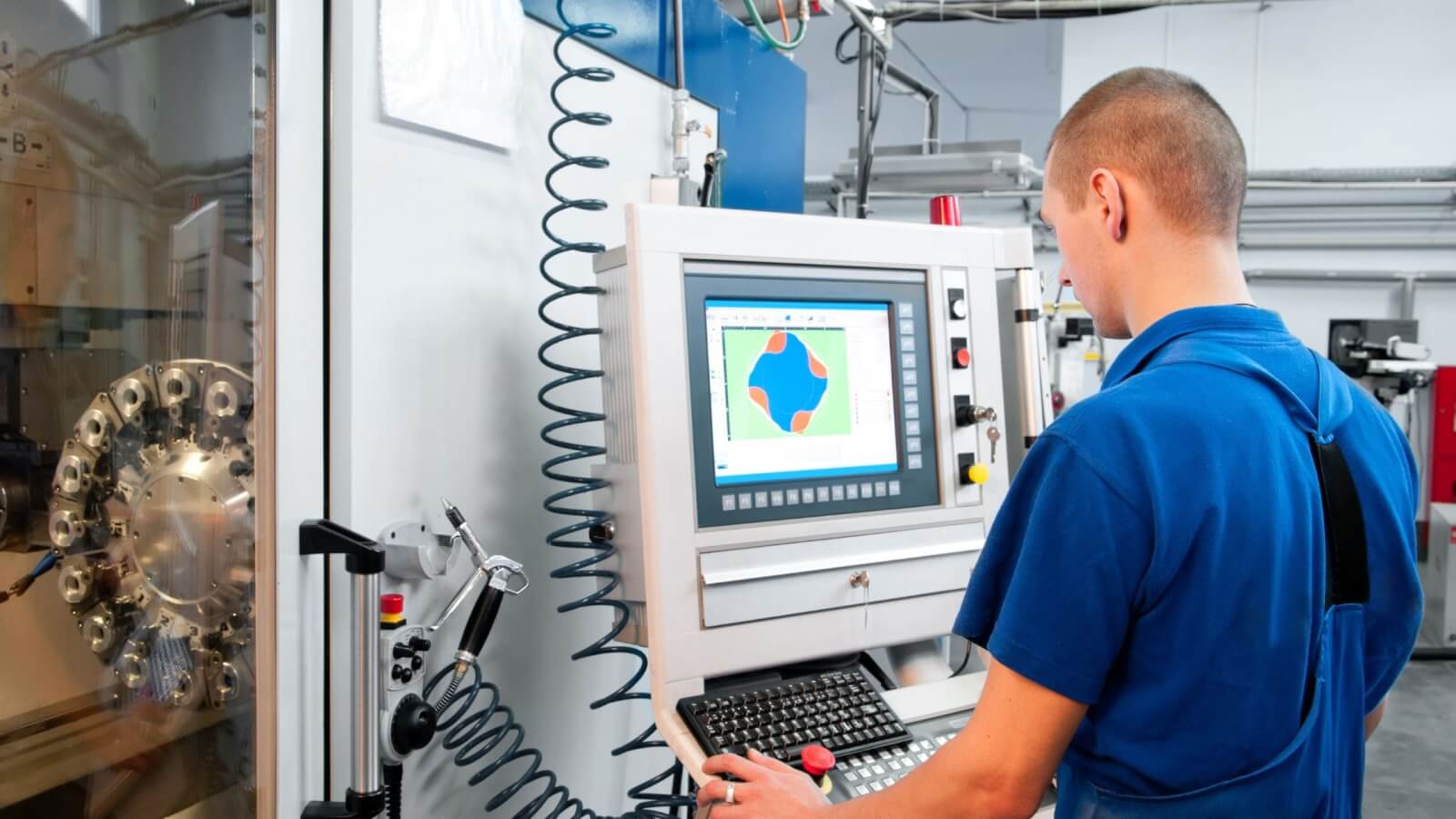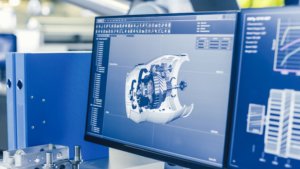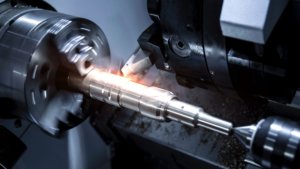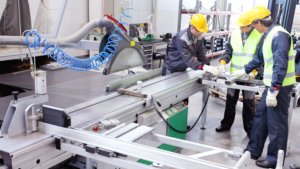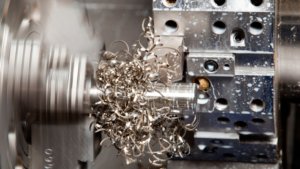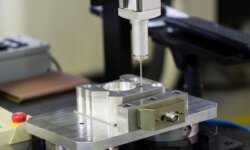Over the years, there have been many advances in manufacturing processes. The Fourth Industrial Revolution has led to one of these – CNC machining and milling. CNC stands for Computer Numerical Control. CNC machines perform computer numerical control machining, a precision manufacturing process involving core-programmed computer software.
The manufacturing industry, especially, benefits from CNC machining. Compared to manual machining, CNC technology improves efficiency and accuracy, makes production faster, and leads to safer and cheaper operations.
As you might expect, there are disadvantages as well. We’ll look at the advantages of CNC machines and some of its disadvantages so you can decide for yourself whether it’s something you’d like to take advantage of.
CNC Machining Overview
The CNC machining and CNC milling processes use a machine and tooling that’s controlled by a numerical software program. Computerized controls and cutting tools remove material from a workpiece during the CNC milling process. The result is a custom-designed part.
The CNC machine has a table that rotates or moves the workpiece in different planes. CNC milling machines convert a 3D Computer Aided Design or CAD model into a series of computer instructions. These dictate the action of the CNC machine and tooling and move the workpiece automatically.
CNC milling and machining is used in many industries, for example:
- Automotive
- Aerospace
- Medical
- Agriculture
- Construction
- Dental
- Firearms
- Electronics
- Metalwork
- Publishing
- Production
- Manufacturing
- Transportation
- Hospitality
- Woodwork
Using this method, manufacturers can create precise made-to-order parts.
What are the Advantages of CNC Machines?
CNC machining has become very popular across a wide range of industries for many reasons. In many cases, CNC milling benefits offer manufacturers and machine shops so much more. And it has led to manual equipment being replaced.
Here are 14 advantages of CNC machines offer.
1. High Precision and Improved Accuracy
One of the most significant benefits of using CNC machining compared with manual operations is precision. It’s possible to create parts that meet precise specifications without the need for constant attention from a skilled operator.
With CNC milling, human error is eliminated because the machines rely on computer instructions for fabricating parts. However, there is still some control over the manufacturing process by the operator of the CNC machine.
The accuracy of the CNC milling project depends very heavily on the operator. It is down to the operator to control the operating environment and cutting tool calibration. They also need to recognize when the tooling is getting too dull and unable to create the optimum results when in contact with raw material. But overall the risk of human error is significantly reduced.
It’s relatively easy to achieve tolerances as small as 0.004 mm and create complex parts. However, it’s worth pointing out that not all CNC machines are created equal. Not all CNC machines are capable of creating high-precision parts.
Defense and aerospace industries rely on high-precision CNC machined parts. Being able to create such precise components according to specifications could save lives.
2. Endurance
Manual machining processes can only continue as long as there are skilled workers present to work the machines. The manufacturing process stops when workers take a break or go home at the end of their working day.
However, operating CNC machines for 24 hours a day, 365 days a year is one of the main advantages. It depends on the project’s design, but in many cases, the operator can program the machine’s computer and set it to create the required part as many times as necessary.
Because less human intervention is required than manual machining, fewer experienced engineers and skilled workers are needed. As a result, machine shops can increase their production capacity.
CNC machines also allow for quick production changes. If a small number of parts are required, the operator sets the machine for the small order. Once completed, they can change the CNC (Computer Numerical Control) program for the next production run. Such flexibility means a CNC machine shop can complete many orders, including individual prototypes and large batches of identical components.
CNC machine endurance is further improved by their need for minimal maintenance. Looking to the future, Internet of Things (IoT) technology could mean that CNC machines use sensors to keep track of the level of wear on various parts. When wear is detected, the sensors send signals to the operator. For the operator, this means they don’t have to wait for the machine to break down before they do something.
It’s also possible that the IoT could integrate CNC machines with other technology, particularly robots. The removal and packing of the finished product could be taken out of human hands entirely.
3. High Production and Scalability
After the operator has programmed the machine with the necessary design specifications, production can take place. Once the CNC machine has started a production run, creating parts takes no time at all.
As well as producing large numbers of parts, modern-day CNC machines are also very scalable. What makes them different from conventional machines and manual production processes is that a CNC machine can be programmed to produce one single item or large quantities. There are no limitations to the number of parts you can manufacture, allowing companies to use their resources and finances more efficiently.
4. Speed
Another of the numerous advantages CNC machining offers is its higher speed. When CNC machines are used, operators can be much more efficient because the machines can use their fastest settings. CNC machines can run 24/7 without running out of steam. They don’t need a break for coffee or lunch. No holidays need to be booked or any kind of time off. There are no trade-offs with a CNC machine.
Such benefits, together with the ability to maintain a high degree of accuracy and minimal waste of material resources, make CNC machining and milling one of the best ways to ensure production is efficient, fast, and scalable with a lower cost liability.
When more conventional milling methods are used, an operator is often required to manually operate the machine and change tooling depending on the cutting operation needed. This can be exceedingly time-consuming and inefficient.
5. Enhanced Capabilities
A CNC machine usually has a rotating carousel that can carry up to 30 tools. These tools can be automatically swapped out during the milling and machining process.
CNC milling machines with sophisticated design software produce complex shapes that a regular manual machine cannot duplicate.
CNC machines are much more efficient than any engineer, no matter how skilled or experienced. With the right software, a CNC machine can produce a workpiece of virtually any size, shape, or texture.
6. Capable of producing even the most complex parts
The CNC machining process can create virtually any component you might think of. These machines can perform a wealth of fabrication and CNC milling operations, including shearing, flame cutting, punching holes, and welding metal sheets.
Because of their incredible precision, CNC machines can be used to produce shapes of extreme complexity.
7. Wide Range of Materials Supported
CNC machines are compatible with a range of materials such as composites, metals, carving foam, rigid foam, phenolic materials, and plastics.
Regarding material selection for CNC milling, factors such as design tolerance, fastening, hardness, stress resistance, and heat tolerance must be taken into account when choosing.
8. Less Dependability on Human Labor and Fewer Human Errors
CNC machines are precision turning machines that operate autonomously. No manual intervention is required, which bypasses the possibility of human errors.
Software programs and codes govern the end-to-end CNC machining process, and the machines can deliver flawless complex designs with great accuracy.
9. Uniform Product and Design Retention
The input is immutable throughout the production process, no matter how many cycles are performed. Unless any changes are made deliberately, the final products are consistent.
10. Digital Simulations of Prototypes
Simulations of prototypes are possible using CNC machining and milling. This allows manufacturers to check the program’s efficacy before it is put into full-time production mode.
11. Lower Costs
The initial price of a CNC machine may be costly but lower operational costs more than compensate for this. The high output rate, minimal mistakes, and low production costs of CNC machining make it cost-effective. Less training is required, which is a further cost saving. Operators can also learn how to use CNC machines virtually, eliminating the cost and need for training workpieces. All these factors make CNC machining very attractive.
12. Improved Safety
An operator only interacts with a CNC machine to enter the code and maintain the machine. Apart from that, the process is entirely automated. Operators don’t have to put themselves near the cutting tools, which can improve the overall safety of the workplace.
Introducing CNC machines into manufacturing has led to fewer occupational health and safety accidents. While a CNC machine may not be as simple to operate as a cordless drill, for an operator with some training and practice, they are relatively simple to use.
13. Low Maintenance
The final point in the list of the many advantages of CNC milling machine technology is that it typically requires minimal levels of maintenance. Generally, the service involves changing the cutting implements at the indicated interval and a small amount of light cleaning. CNC machines are low maintenance, and any servicing can be performed in-house without needing professional maintenance engineers, which saves money.
14. Full Mobility Will Hit The CNC Industry
Just as an individual can now access the internet no matter where they might be, soon the potential for a completely mobile CNC machine will become a reality.
Currently, some CNC machines can be used at home to cut wood, plastic, and metal while sitting on a tabletop. In manufacturing facilities, CNC machines provide the ability to fully automate the process to address a complex project.
What are the Disadvantages of a CNC Milling Machine?
As you might expect, alongside the advantages of CNC machining, there are a few disadvantages that it’s only fair to mention.
Cost
CNC machines tend to be more expensive and require a more substantial initial investment than manual machines. However, as these machines become more widely available and used, supplies will increase, and costs will go down.
Skills Loss and Unemployment
An element of skills loss comes with the increased use of CNC machines. Fewer manual machine operators are required, resulting in new students not being trained in these skills. Eventually, it could result in a total loss of traditional manual machining and milling skills.
Not Enough Qualified Technicians
While the machining process is automated, on the whole, highly trained technicians or experienced engineers are still required to program the machines, make calculations, and supervise the machining process.
Not all machine shops can find these highly trained operators to run the machines, which might result in low-quality machined parts.
Increased Material Wastage
CNC machining is a subtractive manufacturing method. The process starts with a block of material from which portions are cut away until the finished product is left. The result is greater material wastage than produced by additive manufacturing processes like 3D printing.
Is CNC Machining Better Than Conventional Machining?
As you can see, there are lots of CNC machining advantages. If you’re considering adding CNC machines to your manufacturing process, here are some of the reasons you may or may not want to:
- CNC machining services require no extensive skills or experience
- Products can be replicated thousands of times
- Less labor is required to operate CNC machinery
- CNC software makes your production options more versatile
- With CNC machines, there is no need for prototypes
- CNC machining fits the skills of modern workers
- CNC machining uses oil-based coolants that result in a better quality finish
- CNC machining services create lighter and stronger parts with the help of complex geometry
There are many CNC machining advantages compared with conventional machining. These include greater design freedom, higher accuracy, and finer features.

Conclusion
CNC machining is a form of manufacturing that uses computer-controlled machine tools to create parts and products. The main advantages of CNC machining over traditional methods are greater accuracy, more precise control, and higher efficiency.
Precision-turned components milled by CNC machines are of higher quality than those from manually operated machines. In addition, CNC machining offers other advantages that will give a company a competitive edge and help it stay ahead of the competition.
Thanks to these advantages, CNC machining is suitable for a wide range of applications across many industries.
3ERP provides cutting-edge CNC machining services and CNC milling services that boost your company’s potential and support its continuous development. From a single project to one that requires hundreds or thousands of parts, 3ERP specializes in quick delivery in as few as 10 days. Precise, accurate, fast, and affordable – try 3ERP today and see how we make your ideas a reality. Contact us today for more details.
